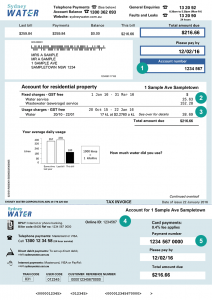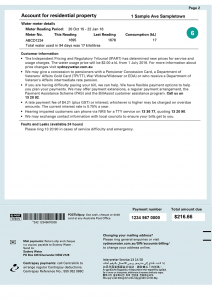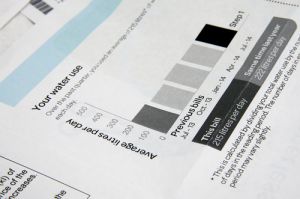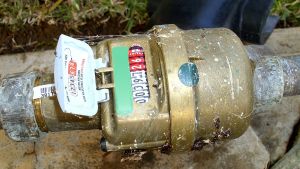Sydneysiders are blessed with some of Australia’s cleanest water, most of which is sourced naturally from Lake Burragorang at Warragamba. From here, water undergoes stringent testing and is filtered to ensure water quality is of a high standard, as well as being safe to drink. But just how much does this water cost? In this guide, we take a look at the price of water in Sydney and surrounds, plus list a few handy tips on how to read your water bill and understand all those confusing charges.
Skip ahead to:
- Understanding your water bill charges
- How much are water rates in Sydney?
- How to read your water bill
- How often do water rates change?
- Sewerage and other water bill charges
- How to read your water meter
Compare Electricity Plans
Understanding your water bill charges
Water bills comprise of two key parts – fixed and usage charges. These charges should be consistent across most of the city, however will vary for those living in areas like Rouse Hill and Sydney Olympic Park. This is due to different water management systems in these regions which attract a couple of extra charges.
- Fixed charges: A set fee for being connected to the Sydney Water network. This will be listed as ‘water service charge’ on your bill. Residents in the Sydney Olympic Park area will also have a fixed charge for being connected to the recycled water service.
- Usage charges: Refers to the volume of water that you consume in your home. The amount you’re charged for usage will depend on where you live in Sydney, as some areas like Sydney Olympic Park have separate fees for recycled water that’s generated from desalination plants.
How much are water rates in Sydney?
Residential customers will be billed by Sydney Water, a New South Wales Government-owned corporation, responsible for supplying water to more than five million people. Sydney Water is the sole operator for Greater Sydney, Illawarra and the Blue Mountains. Here are the current water rates set by Sydney Water:
Sydney water service charges
- Water service charge (if you have a meter): $24.30 per quarter
- Water service charge (if you don’t have a meter): $119.77 per quarter
- Recycled water service (Sydney Olympic Park): $6.08 per quarter
Sydney water usage charges
- Water usage charge: $2.11 per kilolitre
- Recycled water usage charge: $1.89 per kilolitre
- Recycled water usage charge (Sydney Olympic Park): $1.96 per kilolitre
Source: Sydney Water, Prices for your home, 2019-20. Accurate as of May 2020.
How to read your water bill in Sydney
A bill from Sydney Water will usually consist of two pages. The first page of a water bill lists details such as the account number (1), fixed charges (2), usage charges (3), online ID number (4) and payment number (5). Here’s what a Sydney water bill will typically look like:

On the second page, there’ll be water meter details (6) including the meter reading period, as well as some customer information on the terms and conditions and other bill payment options down the bottom of the page.

How often do water rates change in Sydney?
In Sydney, water charges tend to change on July 1 each year. Water rate changes are set by the Independent Pricing and Regulatory Tribunal (IPART), a state government body that regulates the state’s utilities, such as water, gas and electricity. IPART also determines the maximum quarterly charge for water in NSW.
Are bills monthly or quarterly in Sydney?

Water bills are issued quarterly in Sydney after a meter reading has taken place. If you don’t have a meter, your bill will be sent at the start of each quarter. Another option is monthly billing, however you’ll need to contact Sydney Water to arrange this. It’s recommended that bill-payers register for ‘eBill’ on the Sydney Water website, where they can manage their account online.
How much is 1 kilolitre (1kL)?
One kilolitre is equal to 1,000 litres of water, or one cubic metre of water (1m3). According to Sydney Water, a single person uses about 200 litres of water a day. That’s a lot of H20 used when hosing the garden, showering, flushing toilets, washing clothes and cleaning dishes.
Sewerage and other water bill charges
It’s never as simple as just paying for water, as you’ll likely discover a range of other charges on your water bill. This is because most households will incur an ongoing fee for services like sewerage or ‘wastewater’, plus additional fees depending on where you live. Here’s a few extra costs you may encounter on your next water bill:
- Wastewater service charge: $154.76 per quarter
- Stormwater service charge (house): $19.83 per quarter
- Stormwater service charge (unit): $6.19 per quarter
- Rouse Hill stormwater drainage charge: $37.52 per quarter
- Rouse Hill land charge: $97.88 per quarter
- Late payment fee: $5.18
- Dishonoured payment fee: $15.55
Source: Sydney Water, Prices for your home, 2019-20. Accurate as of May 2020.
How to read your water meter

Most homes in Sydney will usually have a water meter located at the front of their property, while others may have a secondary purple meter for recycled water. Your water meter will either have a digital display or a dial face display.
Digital display meters have six to eight numbers displayed which is broken up into black and red numbers. Black numbers represent kilolitres and red numbers measure litres. For dial face display meters, it will usually have a black panel of numbers at the top which measure kilolitres, while litres are found on each dial. Litre dials are read from left to right.
It’s worth pointing out that Sydney Water will normally conduct a water meter reading every three months, provided they have safe access to your meter. In the event that you’re asked to carry out a meter read, you can submit the reading via the Sydney Water website. You’ll need to fill in your personal details as well as your account number, meter serial number and meter reading.
Why is my water bill so high?
No two water bills are ever the same, and this may cause you to scratch your head. It can feel natural to question the amount due, but your water bill is likely going to be accurate, especially if you’ve carried out your own meter reading. It’ll usually be a case of your water usage habits changing over a billing period, or there is a leak at your property.
Remember that each water bill lists your previous water reading which you can compare to your current bill, helping you identify how much water you’re using on average in a quarter. If you still have any doubt, it’s best to contact Sydney Water directly to discuss your options.
 Image credits: veryulissa/Shutterstock.com, Sydney Water, gmstockstudio/Shutterstock.com, Wikipedia Commons
Image credits: veryulissa/Shutterstock.com, Sydney Water, gmstockstudio/Shutterstock.com, Wikipedia Commons

Share this article